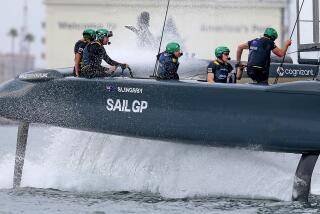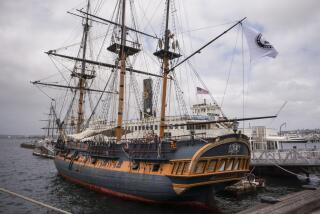Tall Ships Throw Fate to Wind in Channel Race
The winds of fate may not have blown the America’s Cup races Oxnard’s way, but the Channel Islands Harbor did get the tall ships.
Seven tradition-laden vessels will sail from the harbor Saturday on a two-day race capping a weekend of designed to draw attention to sailing in the Channel Islands.
“There are only about a dozen of these races each year in the United States. It’s really prestigious,” said Gene Proffitt, district commodore for the association of Santa Barbara Channel Yachting Clubs, which is officiating the race. “This will show people we’re not the backwaters.”
The exhaustively detailed replicas of historic boats will arrive Friday evening and will be visible throughout the harbor until they hoist anchor Saturday morning, said Bob Carter, the executive director of the Channel Islands Harbor Assn.
New Boston Tea Party
Maritime Days activities begin at 6 p.m. Friday with a tongue-in-cheek re-enactment of the Boston Tea Party, a clambake and a street dance on Fisherman’s Wharf. Exhibitions, pancake breakfasts and musical entertainment continue through Sunday at the harbor.
Then beginning at 9 a.m. Saturday, canvas sails will unfurl along tall wooden masts and the tall ships will vie for a pennant in much the way cargo ships’ crews competed for gold in the days of yesteryear.
Thundering volleys from a Civil War cannon believed to be the only remnant of a renowned Union warship, the Kearsage, will signal staggered starts designed to compensate for the ships’ differing capabilities.
The tall ship Californian, considered the favorite--it is the event’s longest ship at 93 feet and the race’s winner for two years running--will bring up the rear at 10:30 a.m.
“We want to spice up the competition,” said Steve Christman, president of the Nautical Heritage Society in Dana Point. The society, which owns and maintains the Californian, is sponsoring the race’s first leg, which ends late Saturday at Marina del Rey.
Accessible Location
The harbor was chosen as the starting place for the two-day race which concludes Sunday in Dana Point because of its public accessibility and its size and depth, said Eric Christman, another society official who also is the son of its president. “It’s better when you have a location where you can get all the ships safely into a harbor.”
The Channel Islands Harbor, which unsuccessfully bid for the next America’s Cup races that San Diego claimed, is one of three ports for the Californian. As the state’s official tall ship, it represented California in the 1984 Olympics and at other events.
Except for a fishing vessel from the 1920s, all the ships model historic sailing vessels from the Revolutionary War to the Gold Rush. Though some will be chartered by hobby sailors, they will be crewed largely by full-time professionals who earn their boats’ keep either by giving tours or hauling cargo, Steve Christman said.
Channel Islands restaurateur Michael Koutnik was inspired to charter Spike Africa--a 1977 replica of a turn-of-the-century schooner--by “that certain something that comes with sailing a wooden boat.”
“There’s a completely different sound when you go through the water--more solid, comforting,” he said. “You can envision yourself in days gone past.”
The Lure of Canvas
Winds add a lilt to traditional canvas sails, Proffitt said.
“Older, classic sails work more so you hear the wind going through the rigging,” he said. “To me, it’s like sitting in a peaceful valley and listening to the wind going through the trees. When you tack in a new boat, it sounds like cellophane crinkling. . . . It’s the difference between antique furniture and particle board covered with Formica.”
Supporters say Saturday’s competition harkens back to the origins of sailboat racing, when a ship’s crew would receive gold bonuses for beating competing shippers to a port, Koutnik said.
“You have to remember ships were the main suppliers of goods until the railroads were built,” said Koutnik, who also is a director for a foundation that is building the Ventura County Maritime Museum at Channel Islands Harbor. “If you arrived a day ahead of the other boats, you could curb the market” for a particular cargo.
The contest represents a 45-mile extension of a 21-mile race that has been under way for two years in Orange County. The winner of the first leg of the race will fly a red, white and blue pennant inscribed with the motto of American ships during the War of 1812, “Catch Me If You Can.”
“The American ships were so fast back then that they would fly these pennants to taunt the British,” Steve Christman said.
Rare Events
Races such as Saturday’s are becoming as rare as the vessels they celebrate in the wake of the sinking of two tall ships since 1984, said Susan Bailey, executive director of the American Sail Training Assn. in Newport, R. I. The group formerly sponsored the hemisphere’s largest and most prestigious tall ship race, from Bermuda to Nova Scotia.
“The insurance companies got sort of skittish and we found it exorbitant to get liability coverage,” she said.
Even though a few yachting groups still sponsor fiercely competitive tall ship races, most events for traditional vessels have softened into spectacles such as the nautical pageants that accompanied the 1984 Summer Olympics, the 50th anniversary of the Golden Gate Bridge and the Statue of Liberty renovation.
Tall ship, a classification coined in 1973 by the American Sail Training Assn., is a term describing any traditional, wooden sailing vessel.
Traditional wooden sailing vessels began to die out in this country during the Civil War. What ships weren’t sunk in an effort to sabotage commerce were upstaged with the introduction of the steam engine, which opened the door to more efficient rail transportation.
Working Boats
While all of the vessels that will set sail from the Channel Islands are considered working boats because they earn their keep, none do the dirty work associated with the coastal schooners that carried raw goods and slaves to Eastern ports and finished products out West.
Three boats in this weekend’s competition, for instance, are used to teach vivid lessons about history, sailing and science. Most serve as charter vessels that occasionally haul equipment and supplies for sailboat races or transport cargo for symbolic purposes.
For instance, the Californian, a 1984 replica of a Coast Guard cutter, will carry samples of Ventura County products to ports up and down the coast in celebration of the Oct. 10 centennial of the railroad’s coming to the county, Carter said.
Only the Swift of Ipswich, a 1939 replica of the 1778 Revolutionary War schooner, the Swift, has been used for the sort of work usually associated with pirates and galleons. In 1968, owner Richard Headley took it on a treasure hunt for the Loot of Lima, the riches of an oligarchy overthrown during a Latin American revolution.
Headley said he came home empty-handed from the voyage that took him to an island off Panama, but that he didn’t mind because he had lived out a childhood fantasy.
“As a kid,” he said, ‘Treasure island’ was my favorite book.”
More to Read
Sign up for The Wild
We’ll help you find the best places to hike, bike and run, as well as the perfect silent spots for meditation and yoga.
You may occasionally receive promotional content from the Los Angeles Times.






